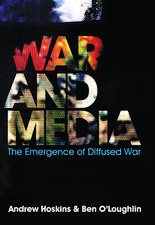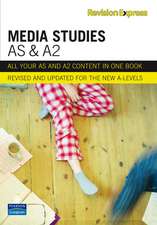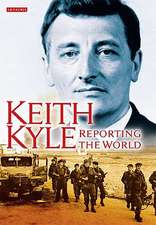Cinematic Emotion in Horror Films and Thrillers: The Aesthetic Paradox of Pleasurable Fear: Routledge Advances in Film Studies
Autor Julian Hanichen Limba Engleză Paperback – 15 mar 2012
| Toate formatele și edițiile | Preț | Express |
|---|---|---|
| Paperback (1) | 441.20 lei 6-8 săpt. | |
| Taylor & Francis – 15 mar 2012 | 441.20 lei 6-8 săpt. | |
| Hardback (1) | 1114.98 lei 6-8 săpt. | |
| Taylor & Francis – 26 mar 2010 | 1114.98 lei 6-8 săpt. |
Din seria Routledge Advances in Film Studies
-
 Preț: 319.20 lei
Preț: 319.20 lei -
 Preț: 310.14 lei
Preț: 310.14 lei -
 Preț: 349.02 lei
Preț: 349.02 lei -
 Preț: 301.93 lei
Preț: 301.93 lei -
 Preț: 310.65 lei
Preț: 310.65 lei -
 Preț: 310.85 lei
Preț: 310.85 lei -
 Preț: 313.47 lei
Preț: 313.47 lei -
 Preț: 372.42 lei
Preț: 372.42 lei -
 Preț: 356.77 lei
Preț: 356.77 lei -
 Preț: 349.10 lei
Preț: 349.10 lei - 18%
 Preț: 1106.81 lei
Preț: 1106.81 lei -
 Preț: 416.06 lei
Preț: 416.06 lei - 18%
 Preț: 1116.02 lei
Preț: 1116.02 lei -
 Preț: 449.05 lei
Preț: 449.05 lei -
 Preț: 388.85 lei
Preț: 388.85 lei - 18%
 Preț: 1112.21 lei
Preț: 1112.21 lei - 18%
 Preț: 1112.34 lei
Preț: 1112.34 lei - 18%
 Preț: 1106.81 lei
Preț: 1106.81 lei - 18%
 Preț: 1106.85 lei
Preț: 1106.85 lei -
 Preț: 382.86 lei
Preț: 382.86 lei -
 Preț: 475.65 lei
Preț: 475.65 lei -
 Preț: 387.31 lei
Preț: 387.31 lei - 18%
 Preț: 729.62 lei
Preț: 729.62 lei - 18%
 Preț: 1056.95 lei
Preț: 1056.95 lei - 18%
 Preț: 1058.43 lei
Preț: 1058.43 lei - 18%
 Preț: 1161.62 lei
Preț: 1161.62 lei - 30%
 Preț: 848.15 lei
Preț: 848.15 lei - 18%
 Preț: 1109.99 lei
Preț: 1109.99 lei - 18%
 Preț: 1054.43 lei
Preț: 1054.43 lei -
 Preț: 398.48 lei
Preț: 398.48 lei - 18%
 Preț: 1117.43 lei
Preț: 1117.43 lei - 18%
 Preț: 1115.51 lei
Preț: 1115.51 lei - 18%
 Preț: 1114.30 lei
Preț: 1114.30 lei - 18%
 Preț: 1053.16 lei
Preț: 1053.16 lei - 18%
 Preț: 1057.75 lei
Preț: 1057.75 lei - 30%
 Preț: 820.32 lei
Preț: 820.32 lei - 18%
 Preț: 1112.34 lei
Preț: 1112.34 lei - 18%
 Preț: 1057.75 lei
Preț: 1057.75 lei - 18%
 Preț: 1117.43 lei
Preț: 1117.43 lei
Preț: 441.20 lei
Nou
Puncte Express: 662
Preț estimativ în valută:
84.43€ • 87.83$ • 69.71£
84.43€ • 87.83$ • 69.71£
Carte tipărită la comandă
Livrare economică 14-28 aprilie
Preluare comenzi: 021 569.72.76
Specificații
ISBN-13: 9780415516570
ISBN-10: 0415516579
Pagini: 314
Ilustrații: Illustrations
Dimensiuni: 152 x 229 x 17 mm
Greutate: 0.42 kg
Ediția:1
Editura: Taylor & Francis
Colecția Routledge
Seria Routledge Advances in Film Studies
Locul publicării:Oxford, United Kingdom
ISBN-10: 0415516579
Pagini: 314
Ilustrații: Illustrations
Dimensiuni: 152 x 229 x 17 mm
Greutate: 0.42 kg
Ediția:1
Editura: Taylor & Francis
Colecția Routledge
Seria Routledge Advances in Film Studies
Locul publicării:Oxford, United Kingdom
Public țintă
Postgraduate and UndergraduateRecenzii
"In this compelling and wonderfully readable volume, Julian Hanich seeks to analyze the specific pleasures of cinematic fear by first canvassing the generic pleasures of cinema: the visceral thrill of adrenalized action sequences; the transgressive charge of forbidden fruit such as R-rated movies and identification with villainous characters; and the smug intellectual pleasures of film aficionados demonstrating their cultural capital through appreciation of intertextuality, genericity, and aesthetic strategies." --Jane Stadler, Projections
"There are several elements of this book that are appealing. First, it is clearly and engagingly written [...]. Second, the author is eclectic in his resources, drawing from scholarship in both German and English, from phenomenology, cognitive film theory, and cultural studies. [...It] is a substantial achievement."
--Carl Plantinga, author of Moving Viewers: American Film and the Spectator's Experience
"...[an] impressive account of genre, aesthetics, and audience affect..."
"...[a] compelling and wonderfully readable volume [that] make[s] an important addition to scholarship that bridges film and philosophy"
"The difference between Hanich’s work and much scholarship on film and embodiment is his superior ability to contextualize and qualify his claims, thoughtfully developing their implications..."
--Jane Stadler, author of Pulling Focus: Intersubjective Experience, Narrative Film and Ethics
"...Hanich indeed manages to take a fresh, perceptive look at Cinematic Emotion in Horror Films and Thrillers."
--Rolf Löchel in Literaturkritik.de
"A contribution absolutely worth reading [...]. The argument is well-founded and developed in a highly readable fashion throughout the book. It raises many interesting questions. Hence this study could soon become a standard reference for the study of horror films and thrillers."--Rayd Khouloki, Sehepunkte.de and author of Der filmische Raum: Konstruktion, Wahrnehmung, Bedeutung
"There are several elements of this book that are appealing. First, it is clearly and engagingly written [...]. Second, the author is eclectic in his resources, drawing from scholarship in both German and English, from phenomenology, cognitive film theory, and cultural studies. [...It] is a substantial achievement."
--Carl Plantinga, author of Moving Viewers: American Film and the Spectator's Experience
"...[an] impressive account of genre, aesthetics, and audience affect..."
"...[a] compelling and wonderfully readable volume [that] make[s] an important addition to scholarship that bridges film and philosophy"
"The difference between Hanich’s work and much scholarship on film and embodiment is his superior ability to contextualize and qualify his claims, thoughtfully developing their implications..."
--Jane Stadler, author of Pulling Focus: Intersubjective Experience, Narrative Film and Ethics
"...Hanich indeed manages to take a fresh, perceptive look at Cinematic Emotion in Horror Films and Thrillers."
--Rolf Löchel in Literaturkritik.de
"A contribution absolutely worth reading [...]. The argument is well-founded and developed in a highly readable fashion throughout the book. It raises many interesting questions. Hence this study could soon become a standard reference for the study of horror films and thrillers."--Rayd Khouloki, Sehepunkte.de and author of Der filmische Raum: Konstruktion, Wahrnehmung, Bedeutung
Cuprins
List of Figures Acknowledgments Part I Introduction Chapter One: How to Describe Cinematic Fear, or Why Phenomenology? Chapter Two: Multiplexperiences: Individualized Immersion and Collective Feelings Part II Chapter Three: Frightening Fascination: A Phenomenology of Direct Horror Chapter Four: Intimidating Imaginations: A Phenomenology of Suggested Horror Chapter Five: Startling Scares: A Phenomenology of Cinematic Shock Chapter Six: Anxious Anticipations: A Phenomenology of Cinematic Dread Chapter Seven: Apprehensive Agitation: A Phenomenology of Cinematic Terror Part III Chapter Eight: Moments of Intensity: Lived-Body Metamorphoses and Experienced Time Chapter Nine: Moments of Collectivity: The Cinema of Fear and Feelings of Belongingness Chapter Ten: The End Notes Bibliography Index
Descriere
Why can fear be pleasurable? Why do we sometimes enjoy an emotion we otherwise desperately wish to avoid? And why are the movies the predominant place for this paradoxical experience? These are the central questions of Julian Hanich’s path-breaking book, in which he takes a detailed look at the various aesthetic strategies of fear as well as the viewer’s frightened experience. By drawing on prototypical scenes from horror films and thrillers like Rosemary’s Baby, The Silence of the Lambs, Seven and The Blair Witch Project, Hanich identifies five types of fear at the movies and thus provides a much more nuanced classification than previously at hand in film studies. His descriptions of how the five types of fear differ according to their bodily, temporal and social experience inside the auditorium entail a forceful plea for relying more strongly on phenomenology in the study of cinematic emotions.












